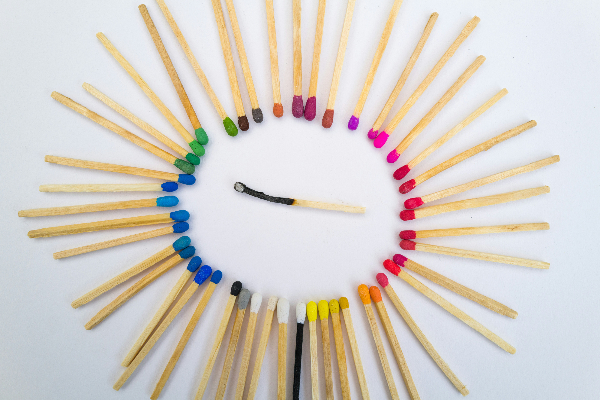Empathy is a Design Mindset – part 1

Melissa Pelochino is the Director of Professional Development at the K12 Lab, Stanford University Design School, known as the d.school. She plays at the intersection of design thinking and K12 education. We talked about design thinking, empathy and the connections between the two. Follow her on Twitter @mpelochino. Martinez: Many schools are now adopting the design thinking process as a way to teach and increase student engagement. Can you tell us what design thinking is?
Pelochino: Design thinking started as a methodology used by designers to solve complex problems, and it has steadily moved into other domains like business and education for some time now. At the most basic level, design thinking is thought of as a 5-step process. The first step is to empathize, which is getting into other people’s shoes… literally! Interviewing people, observing them or immersing yourself in what they do. The second step is to define, which is when designers identify implicit needs that users have, or reframe a problem in a new way. The third step is to ideate, which is when designers brainstorm novel solutions to the problems or opportunities they have identified. The fourth step is to prototype, that is making ideas tangible, often with few resources. The last step is to test, which is inviting users to experience your solution and having them help you make it better.

Below the surface of these steps, there are certain design principles, which we refer to as mindsets… this is where I personally think all the fun is! Design mindsets normally emerge only after having gone through the design thinking process many times.
Martinez: Can you share a few of these design mindsets?
Pelochino: For example, one principle is having an empathetic mindset, which means that you are always looking for multiple and diverse points of view before you make decisions about a problem. Another principle is to have a bias towards action, which is having an idea and doing something about it. Another principle is identifying and challenging assumptions, which is being aware that there are norms accepted as “truth” and challenging them. When designers begin to take on these mindsets, their way of working and their way of being starts to transform… it’s super powerful.
Martinez: Why are so many schools using design thinking?
Pelochino: With the adoption of the Common Core Standards, process-based learning is finally moving to the forefront in our education system. Schools are excited about having a process which promotes critical thinking and rigorous discourse in the classroom. Educators are thrilled about using the process at school-wide or district-wide levels as well, not only in the classroom. There are just so many opportunities to make our current education system better and this process is an amazing lever for change.
Martinez: Empathy seems to be at the core of design thinking. Why is empathy so important?
Pelochino: Empathy is the foundation of design thinking. We find that most people naturally design for themselves simply because they don’t have a process to help them to “get out” of their own head. We are inherently biased and this creates many problems… people get very attached to their ideas, whether they work or not. They often spend lots of time and money on these ideas, and get emotionally involved. This is not conducive to powerful problem solving. Using a process like design thinking helps designers to get into the lives and experiences of others. It helps them be less focused on their own emotions and more focused on what is actually needed. People don’t need to spend time arguing about ideas in meetings; generally speaking, the solutions either work or they don’t.
Martinez: Can you describe some strategies that you use to develop empathy?

Empathy Map, d.school
Pelochino: There are three meaningful ways to develop empathy for others. One way is through interviewing, where you have conversations with your end users. It’s an overlooked and undervalued way to develop empathy, but it is extremely effective. Another way to develop empathy is through observation; we find that what people say, and what people do, don’t always line up. Through observation, designers can pick up on these discrepancies. A third way to develop empathy is by immersing yourself in other people’s’ experiences. For example, if you are redesigning the cafeteria for your school, you would stand in line, get your tray, etc. so you could see for yourself what your users are experiencing. This is a meaningful way to develop empathy!
Martinez: What are some of your designers’ reactions to these activities?
Pelochino: Participants are often surprised by what they notice. We make a lot of assumptions about day-to-day living; we don’t notice a lot of details in our surroundings. Designers often uncover new perspectives after going through these empathy exercises. Observing, interviewing and immersing are only the first steps in the empathy work. The rest of the work includes interpreting what you see, hear, and experience, and making some leaps about what it all means.
Martinez: From an SEL perspective, we say that empathy starts with knowing who you are, because that allows you to connect with others at an emotional level. How do you think that design thinking helps students and teachers be more self-aware?
Pelochino: I think it’s a cyclical process. If you know yourself better, you are able to tap into other people in a more powerful way. By tapping into other people’s perspectives and seeing their point of view, you can continue to refine who you are. Design thinking creates this cycle of learning, where by immersing yourself into other people’s experiences, you learn to uncover more about yourself. Also, any process-based learning requires metacognition. The scientific method, the writing process and design thinking all require that you are intentional about what you do and why you do it. As a result, people become more aware and thoughtful about their behaviors.
Martinez: How do you think that design thinking and SEL can support each other to improve teaching and learning?
Pelochino: Designers very often try to tap into the emotions of the users for whom they are creating solutions, and we use many strategies in order to do this. One example is a strategy called “why laddering”, where you ask the question “why” several times in a row. After asking “why” four or five times, answers tend to be less based on facts or thoughts, and more based on feelings. Participants will say things like “because it makes me feel happy” or “because I feel more in control”. Once designers get to this important emotional information, they can start designing solutions to replicate these emotions.
Martinez: Design thinkers need to be open and leave any judgments behind in order to fully listen and “tune into” their users’ experiences. What could educators do to embrace this mindset?
Pelochino: Designing for others is an act of kindness and fidelity; trust in the design thinking process will help designers to focus on what matters most, the people for whom they are designing. The d.school, in partnership with IDEO, has just launched the Shadow a Student Challenge as part of the School Retool project, which will take place at the end of this month. It’s a crash course on empathy and it’s free! Some other great resources available are the d.school’s method cards and IDEO’s Design Thinking for Educators Toolkit.
In our next post, Empathy is a Design Mindset part 2, we will discuss practical ways to develop empathy the “design thinking” way.
Subscribe to the HEART in Mind Newsletter
Research-Based Strategies for your SEL Toolbox









